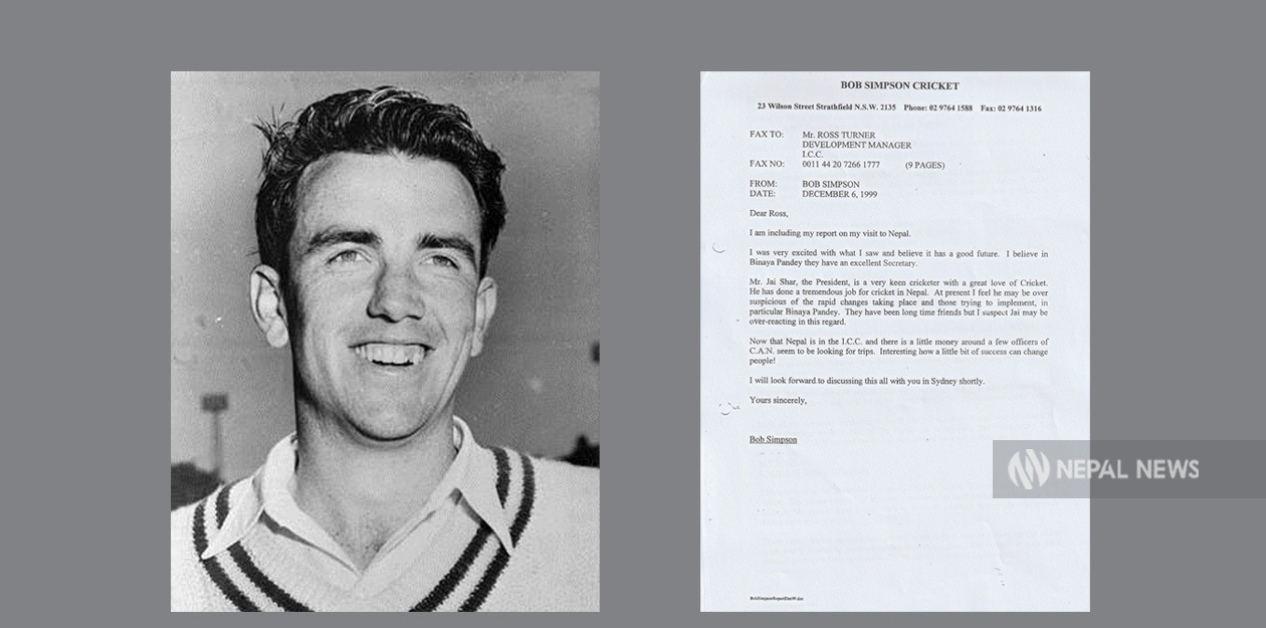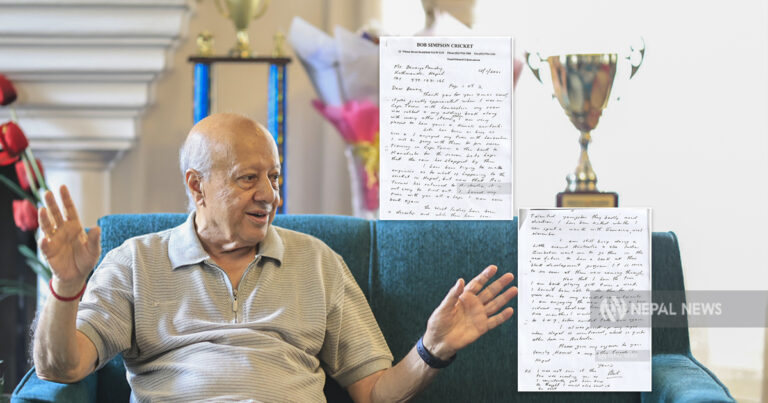
How One Legendary Cricketer’s Insight and Vision Laid the Foundation for Nepal’s Rise in International Cricket

KATHMANDU: “Do they play cricket in Nepal too? But it’s all mountains there. Where would cricket even happen?”
In 1999, during a meeting of the International Cricket Council (ICC) in London, several country representatives raised this question.
Even as participants explained that cricket had long been played in Nepal, this widespread curiosity mixed with surprise needed a permanent answer. To resolve it, CAN (Cricket Association of Nepal) President Jay Kumar Nath Shah and Secretary Binaya Raj Pandey, who were also present at the meeting, proposed one solution — to request ICC’s Development Officer, Australian John Turner, to send a representative to assess the state of cricket in Nepal.
Turner agreed to Shah and Pandey’s proposal. He then spoke with former Australian national cricketer and captain, Bob Simpson. At the time, Bob was coaching the county club Lancashire and also serving as a consultant for the Indian team during that year’s ICC One Day World Cup, held in England. Once the World Cup ended, he was preparing to return home. But unable to decline Turner’s request, he agreed to take the route back home via Nepal.
Cricket had actually been played in Nepal since the Rana era, but it took a long journey before the country could compete internationally. For this tournament, the Cricket Association of Nepal (CAN) had no budget. However, through the initiative of then-Secretary Binaya Raj Pandey, a “Six-a-Side” competition was organized in Kathmandu, raising 180,000 rupees from entry fees.
Thirty thousand rupees were spent on the event itself. From the remaining 130,000 rupees, a national competition was held in Birgunj, and players selected from there were kept in a closed training camp for one month. The players chosen from this camp represented Nepal in its very first ACC Trophy.
On September 6, 1996, at the ACC Trophy held in Malaysia’s capital Kuala Lumpur, Nepal played its debut international one-day cricket match against Bangladesh in the opening game.
In 1998, Nepal hosted the second edition of the ACC Trophy. At that time, CAN (Cricket Association of Nepal) appealed to the government for the first time to build four grounds in Kathmandu (Tribhuvan University, Engineering College–2, and St. Xavier’s School).
With 1 million rupees provided by the then Ministry of Education and Sports, and 200,000 rupees mobilized from internal sources by CAN, the construction of the four grounds and all work up to the completion of the tournament was accomplished.
At the same time, Nepal’s U-19 team became the runner-up in the Youth Asia Cup held in Singapore and, for the first time, was selected to participate in the World Cup in Sri Lanka starting January 11, 2000. A training camp was being conducted in Kathmandu for this purpose.

A copy of a letter from Bob Simpson to former CAN President Binaya Raj Pandey.
In the second week of November 1999, Bob arrived in Kathmandu. He closely observed the training of the U-19 cricket team. Not only that, he taught the young players how to handle matches against Test-playing nations, techniques for catching in the slips, and even gave batting tips.
Bob examined the condition of Nepal’s pitches and witnessed the country’s cricket fever. He traveled to Pokhara to observe Nepali cricket and domestic cricket outside the capital firsthand. He gathered opinions from Nepali players, umpires, coaches, journalists, and supporters. Even in his short two-week stay, he was impressed by CAN’s planning.
Subsequently, on December 6, Bob submitted a nine-page report on Nepali cricket to the ICC, which proved to be a “cornerstone” for the development of cricket in Nepal.
“First, it was a big deal that ICC sent a representative to study Nepali cricket. And having someone of Bob Simpson’s stature come to Nepal was a great fortune for us,” says CAN’s former president Binaya Raj Pandey. “After he presented such a solid report on our country, ICC’s perspective toward us changed.”
After Bob’s report, Nepali officials no longer had to clarify in ICC meetings that cricket is indeed played in Nepal. “We used to say—read the report sent by your own man and see how passionate Nepal is about cricket,” Pandey recalls.
Not only that, immediately after returning from Nepal, on December 25, Bob wrote an article for India’s The Sportstar titled “In the Foothills of the Himalayas.” One sentence in the article read:
“If you want to play cricket at the foot of the Himalayas, Nepal is the destination for you. Captivating Nepal is now among the fastest-rising cricket nations in the world.”
In 2004, during the U-19 World Cup held in Bangladesh, Krishna Prasad Acharya of The Kathmandu Post had the opportunity to interview Bob in Chittagong. Serving at the time as ICC’s High-Performance Manager, he openly praised the young Nepali players.
After Bob’s report, Nepali officials no longer had to clarify in ICC meetings that cricket is indeed played in Nepal. “We used to say—read the report sent by your own man and see how passionate Nepal is about cricket,” Pandey recalls.
When asked, “Which country impressed you the most in the U-19 World Cup?” Bob replied, “Definitely Nepal. They performed really well, even defeating South Africa.”
“Bob was enthusiastic about the future of Nepali cricket. He used to say that the potential of Nepali players, CAN’s efficiency, and the enthusiasm from media to supporters is remarkable,” Acharya recalls, remembering his meeting with Bob.
During his tenure, Bob consistently lobbied at the ICC for the development of Nepali cricket, says Komal Pandey, Bob’s associate when he visited Nepal and Nepal’s first cricket curator. “He spoke with many people here and understood the cricketing environment. He was especially impressed by the insights of CAN Secretary Binaya,” Komal says.
In 2003, an interesting event took place in Mumbai, India. CAN had sent two Nepali spinners, Rajkumar Pradhan (leg-spin) and Sanjam Regmi (off-spin), to train at the Cricket Club of India in Mumbai. At that time, Bob was working as a consultant coach for the CCI (Competition Commission of India). He was so impressed by Rajkumar’s leg-spin that he invited the then BCCI president, Raj Singh Dungarpur, to the camp to see Rajkumar’s talent.
“Bob used to call Rajkumar ‘the Shane Warne of Nepal,’” Regmi remembers.
Former Indian cricket stars Robin Uthappa and Ravindra Jadeja were also present at that Mumbai camp. “When Bob Sir handed me the ball in the nets, Ravindra and Robin would sit outside and watch. He was very caring,” Rajkumar says.
Seeing Bob’s faith in Nepali bowlers, former Mumbai cricket team captain Shishir Hatingadi invited Rajkumar to play cricket in India. Bob, who played a pivotal role in bringing Nepali cricket to the international stage, passed away in Sydney on August 15, 2025 at the age of 89.
Farewell, Bob!